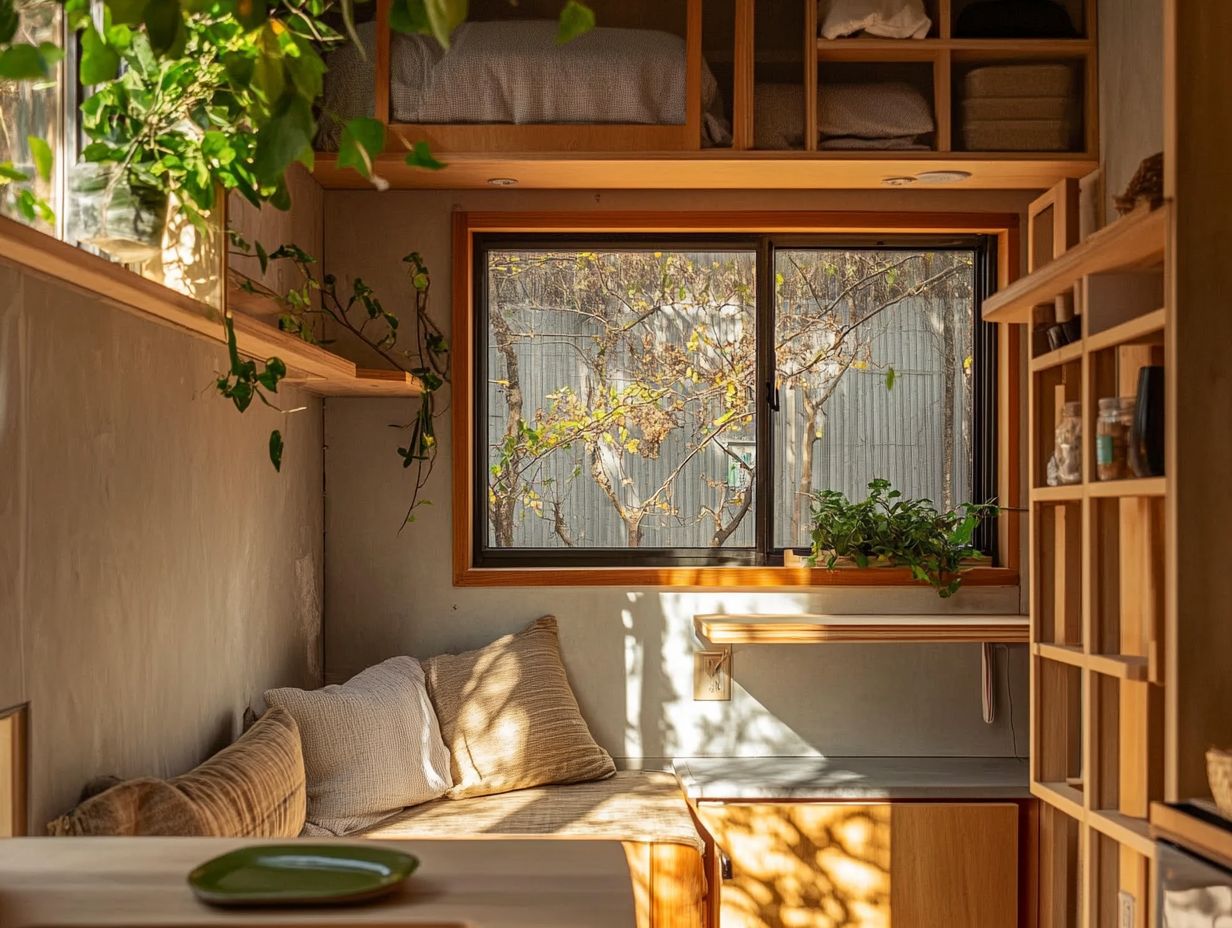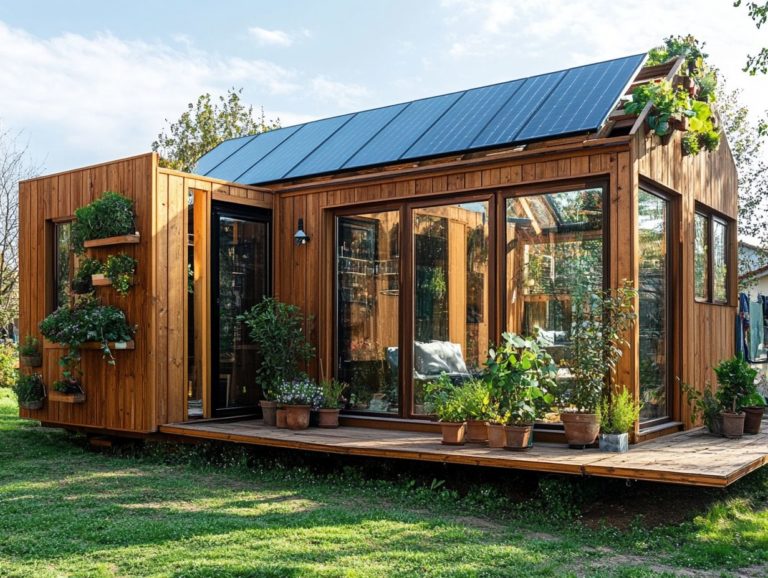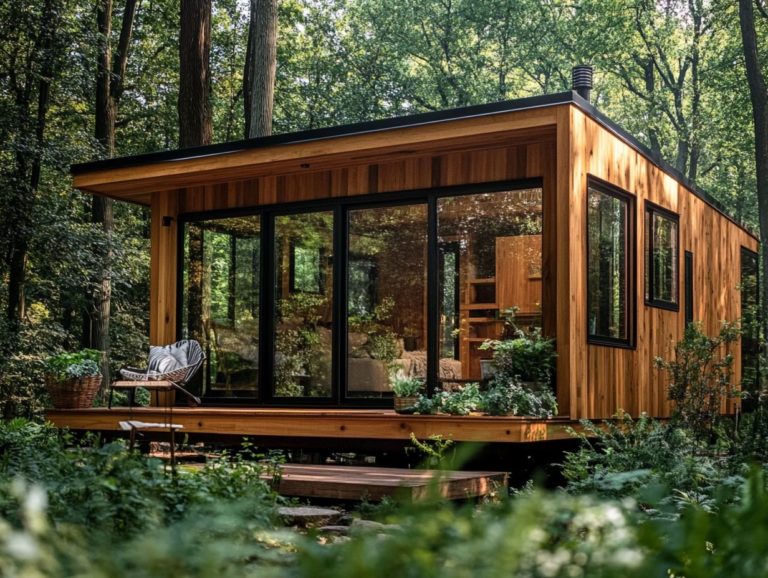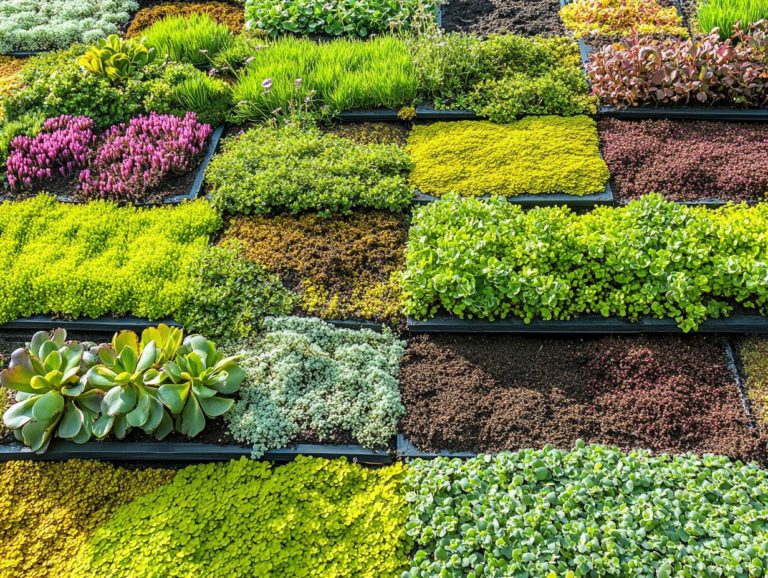5 Ways to Upgrade Your Tiny Home with Sustainable Materials
In a world where sustainability holds paramount importance, upgrading your tiny home with eco-friendly solutions can create a significant impact. This piece delves into five practical avenues to seamlessly incorporate sustainable materials and practices into your living space.
Consider the benefits of using recycled materials for construction and harnessing the power of natural lighting. Each tip not only enhances your home s efficiency but also diminishes your environmental footprint.
Discover how energy-efficient appliances, rainwater harvesting systems, and composting can transform your tiny home into a greener, more sustainable sanctuary.
Contents [hide]
- Key Takeaways:
- 1. Use Recycled Materials for Construction
- 2. Invest in Energy-Efficient Appliances
- 3. Incorporate Natural Lighting and Ventilation
- 4. Utilize Rainwater Harvesting Systems
- 5. Implement a Composting System
- Why Choose Sustainable Materials for Your Tiny Home?
- What Are the Benefits of Using Recycled Materials?
- How Can Energy-Efficient Appliances Help Save Money and the Environment?
- What Are the Advantages of Natural Lighting and Ventilation?
- How Can Rainwater Harvesting Systems Benefit Your Tiny Home?
- What Are the Benefits of Composting in a Tiny Home Setting?
- Frequently Asked Questions
- What are some ways to upgrade my tiny home with sustainable materials?
- Why should I use sustainable materials for my tiny home?
- Can I use sustainable materials in every aspect of my tiny home?
- Are sustainable materials more expensive than traditional materials?
- Can I still achieve a stylish and modern look with sustainable materials?
- Where can I find sustainable materials for my tiny home?
Key Takeaways:

- Upgrade your tiny home with sustainable materials to reduce your environmental impact and save money in the long run.
- Use recycled materials for construction to reduce waste and give new life to old materials.
- Invest in energy-efficient appliances to lower your energy consumption and utility bills.
1. Use Recycled Materials for Construction
Using recycled materials for construction is the cornerstone of eco-friendly tiny home design. This approach promotes sustainable living and significantly reduces the carbon footprint of new builds. By choosing materials like reclaimed wood and upcycled components, you can create structures that are both aesthetically pleasing and environmentally responsible, reflecting your commitment to environmental stewardship.
Opting for metal roofing from repurposed sources enhances durability and adds a sleek, modern appearance that elevates your home s overall style. These materials carry a unique character and charm that brand-new options often lack, ensuring that every construction tells its own story.
Cost-effectiveness is another crucial benefit, as salvaged materials can often be acquired at a fraction of the price of new products, allowing for budget-friendly designs. Companies like Kristina Zagame specialize in sustainable building supplies, showcasing innovative uses of these eco-friendly options that align perfectly with your vision.
2. Invest in Energy-Efficient Appliances
Investing in energy-efficient appliances is essential for anyone dedicated to sustainable living in a tiny home. These devices not only cut down on energy consumption but also lead to remarkable savings on energy costs over time. By choosing appliances that meet Energy Star standards, you can ensure that your daily routines resonate with your environmental values.
You can incorporate high-efficiency refrigerators, LED lighting, and water-saving fixtures to significantly elevate the sustainability of your tiny home. These appliances consume less energy and minimize water usage, further reducing your monthly utility bills.
Over the long haul, embracing this eco-friendly technology can result in lower energy expenses and a smaller carbon footprint. Looking for the best appliances? Discover expert tips that will transform your tiny home!
3. Incorporate Natural Lighting and Ventilation
Incorporating natural lighting and effective ventilation systems is crucial for creating a healthy home environment in tiny homes. This approach enhances indoor air quality and reduces your reliance on artificial lighting. Imagine skylights and strategically placed windows that maximize light exposure. Design methods that use sunlight effectively efficiently regulate indoor temperatures, making your space feel larger and more inviting.
This thoughtful design elevates the aesthetic appeal of compact living and plays a significant role in energy efficiency. Large windows flood your home with daylight, decreasing the need for electrical lighting during the day, which can lead to lower energy bills. Effective cross-ventilation allows fresh air to circulate freely, minimizing moisture buildup and promoting a comfortable atmosphere.
By implementing these elements, including skylights and indoor plants, you can enjoy both visual and thermal comfort. Establish a serene retreat that feels spacious and lively, despite its smaller footprint.
Take action today! Upgrade your tiny home for a more sustainable future and enjoy the benefits of eco-friendly living.
4. Utilize Rainwater Harvesting Systems

Utilizing rainwater harvesting systems is a game-changer for sustainable living, especially for those in tiny homes striving for off-grid independence and effective water conservation. These systems let you collect and store rainwater for various uses, significantly decreasing your reliance on municipal water sources and fostering a self-sufficient lifestyle.
The journey begins with capturing rainwater from your roof and other surfaces, expertly channeled into storage tanks through a well-designed network of gutters and downspouts. This harvested water opens up a world of possibilities, from irrigating your urban garden to growing fresh produce, even when space is at a premium.
But the benefits don’t stop at gardening. You can also use this rainwater for non-potable purposes, like flushing toilets. This further reduces your dependence on treated municipal water. By integrating rainwater harvesting with greywater recycling systems a process that reuses water from sinks and showers you can elevate your water efficiency, creating a closed-loop system that minimizes waste and cuts utility costs. Start your rainwater harvesting today to make a difference tomorrow!
5. Implement a Composting System
Implementing a composting system, especially with composting toilets, is a fantastic way to embrace sustainable living in your tiny home while positively impacting the environment. This innovative approach minimizes waste and converts organic materials into nutrient-rich compost that can enhance your urban gardening efforts.
Composting toilets work by harnessing a natural breakdown process using tiny organisms called aerobic bacteria that help break down waste naturally. This method cuts down on water use and gets rid of the need for regular plumbing. By adopting such systems, you ll find yourself dramatically lowering your ecological footprint.
Follow these steps to kickstart your composting journey:
- Designate a specific composting area.
- Utilize kitchen scraps and yard waste.
- Ensure proper aeration for optimal decomposition.
With a bit of planning and dedication, the benefits of composting will enhance your personal garden and contribute to larger environmental objectives.
Why Choose Sustainable Materials for Your Tiny Home?
Choosing sustainable materials for your tiny home reflects a commitment to eco-friendliness and long-term environmental stewardship. This decision offers benefits that go far beyond aesthetics. By prioritizing green materials and innovative building techniques, you can dramatically reduce your carbon footprint while crafting a living space that resonates with your values and dedication to sustainability.
This choice not only contributes to a healthier planet but also leads to significant cost savings over time. Energy-efficient materials often result in lower utility bills and reduced maintenance costs. A focus on durability and quality enhances your overall quality of life, ensuring that your spaces are not just functional but also nurturing and uplifting.
Insights from experts like Kristina Zagame underscore the importance of selecting materials that are both ethically sourced and sustainable. These choices harmoniously blend environmental responsibility with aesthetic appeal. Ultimately, this approach creates a living space that supports a fulfilling and meaningful lifestyle.
What Are the Benefits of Using Recycled Materials?
Imagine transforming your tiny home with recycled materials. Using these materials brings a wealth of benefits, from reducing your environmental impact to saving on costs, making it an astute choice for the eco-conscious builder.
Not only do these materials divert waste from landfills, but they also impart a unique aesthetic that embodies sustainable living principles. Incorporating items like reclaimed wood from old barn structures or recycled steel allows you to craft durable and eye-catching features that tell a compelling story.
These materials often come at a fraction of the price compared to new alternatives, enabling budget-friendly customization that doesn t skimp on style. Insulation made from recycled denim or bottles cuts down on energy consumption and enhances comfort in your living space.
Using such materials inspires a sense of creativity and individuality, transforming your tiny home into a truly one-of-a-kind sanctuary.
How Can Energy-Efficient Appliances Help Save Money and the Environment?

Investing in energy-efficient appliances now can save you money and protect our planet. These appliances are designed not just for financial savings but also to help the environment.
By choosing these appliances, you can reduce your energy bills while minimizing your ecological footprint. They utilize advanced technologies that consume significantly less energy than traditional counterparts.
Take, for instance, ENERGY STAR-rated refrigerators and washing machines; they use smarter sensor systems to optimize performance, conserving electricity and reducing waste. Over time, the total savings from using such appliances can add up to hundreds, if not thousands, of dollars on your utility bills.
By opting for energy-efficient models, you re not just saving money; you re also playing a crucial role in decreasing greenhouse gas emissions and supporting the environment. Understanding the advantages of these energy-saving devices is essential for anyone looking to make more responsible choices in their home.
What Are the Advantages of Natural Lighting and Ventilation?
Incorporating natural lighting and ventilation into your tiny home design comes with a host of advantages. These include improved indoor air quality, making you feel happier and more energetic, and creating a more energy-efficient living environment.
Natural lighting brightens your interior and helps to regulate your circadian rhythms, leading to better sleep patterns and increased productivity. Proper ventilation facilitates the flow of fresh air, reducing indoor pollutants that can cause discomfort or health issues.
To optimize these elements in your tiny home, consider techniques like strategically placing windows, installing skylights, and utilizing open floor plans. These strategies use sunlight effectively to keep your home warm in the winter and cool in the summer while promoting cross-ventilation. For more insights, explore sustainable design practices for tiny houses.
This creates a comfortable and inviting atmosphere, all while minimizing your reliance on artificial heating and cooling systems. Take the first step towards a sustainable home today!
How Can Rainwater Harvesting Systems Benefit Your Tiny Home?
Rainwater harvesting systems offer remarkable benefits for tiny homes. They enhance your water conservation efforts and pave the way for off-grid living, reducing your dependence on municipal water sources.
By capturing and storing rainwater, you can secure a sustainable water supply for everything from irrigation to everyday household needs, including growing herbs and vegetables.
This eco-friendly choice not only slashes your water bills but also makes a real difference in protecting our planet! While the installation process can vary in complexity, it typically involves setting up gutters, downspouts, and storage tanks that can seamlessly integrate into your tiny home s design.
To keep everything running smoothly, routine maintenance like cleaning filters and checking for leaks is essential. This ensures the system s optimal function and longevity.
You can use harvested rainwater for various purposes beyond gardening, including laundry, flushing toilets, and even treating it for drinkable water.
Ultimately, this fosters a self-sufficient living environment that aligns perfectly with your sustainable aspirations.
What Are the Benefits of Composting in a Tiny Home Setting?
Composting in a tiny home offers a wealth of benefits. It reduces waste and enhances soil for your urban garden, making it a crucial element of sustainable living.
By diverting organic waste from landfills, you help mitigate methane emissions, which are potent greenhouse gases. This not only minimizes your carbon footprint but also fosters local biodiversity by creating nutrient-rich soil.
Even with limited space, starting a composting system can be simple and efficient. You can utilize countertop compost bins or worm composting systems to manage food scraps and yard waste without sacrificing precious room.
It s essential to strike a balance between green materials, like fruit scraps, and brown materials, such as dried leaves. Regularly turning the pile and monitoring moisture levels will ensure effective decomposition. This allows you to enjoy the fruits of your labor even in a compact environment.
Frequently Asked Questions

What are some ways to upgrade my tiny home with sustainable materials?
1. Choose reclaimed wood for flooring and furniture. This sustainable option adds rustic charm while saving trees.
2. Install energy-efficient appliances. Switching to high-efficiency appliances, such as refrigerators, stoves, and air conditioning units, can significantly reduce your energy consumption and save you money.
3. Opt for bamboo or cork flooring. These eco-friendly materials are not only durable but also easy to maintain, making them perfect for tiny homes.
4. Use recycled materials for insulation. Instead of traditional insulation, consider recycled materials like denim, wool, or newspaper.
5. Install solar panels. Harness the sun’s power by installing solar energy solutions on your tiny home to reduce your carbon footprint and save on electricity bills.
Why should I use sustainable materials for my tiny home?
Using sustainable materials will help reduce your environmental impact and save you money in the long run. Options such as nontoxic materials and reused building supplies are often more durable and energy-efficient, requiring less maintenance and resulting in lower utility bills.
Explore these sustainable options today to save money and protect our planet!
Can I use sustainable materials in every aspect of my tiny home?
Yes! You can use sustainable materials in almost every part of your tiny home, like flooring and insulation. There are many eco-friendly options available, so research and choose what fits your needs and budget.
Are sustainable materials more expensive than traditional materials?
They can be pricier upfront. However, they often last longer and need less maintenance, making them a smart choice over time. Plus, using sustainable materials can boost the value of your tiny home!
Can I still achieve a stylish and modern look with sustainable materials?
Absolutely! Many eco-friendly materials come in various styles and colors. This allows you to create a unique and trendy look for your tiny home.
Where can I find sustainable materials for my tiny home?
You can find sustainable materials at local hardware stores and eco-friendly home improvement retailers. Online options are also available, plus consider using recycled materials or repurposing items.






